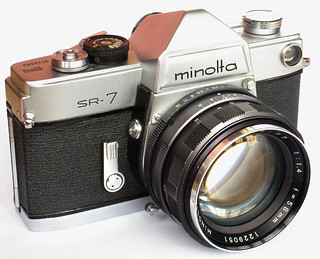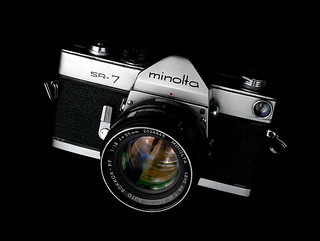Difference between revisions of "Minolta SR-7"
(Removed link to Sylvain Halgand as it has no more info than this page) |
Hanskerensky (talk | contribs) (Added link to user manual page) |
||
| (5 intermediate revisions by 3 users not shown) | |||
| Line 19: | Line 19: | ||
|image_rights= with permission | |image_rights= with permission | ||
}}<!--This ''all rights reserved" image invited to camera-wiki pool 4/2011. Next editor, please check it has been added, or remove/replace.--> | }}<!--This ''all rights reserved" image invited to camera-wiki pool 4/2011. Next editor, please check it has been added, or remove/replace.--> | ||
| + | |- | ||
| + | || | ||
| + | {{Flickr_image | ||
| + | |image_source= https://www.flickr.com/photos/siimvahur/18222667570/in/pool-camerawiki | ||
| + | |image= http://farm9.staticflickr.com/8764/18222667570_b87615dfb0_n.jpg | ||
| + | |image_align= center | ||
| + | |image_text= Minolta SR-7 + Minolta Auto W.Rokkor-HG 1:2.8 f=35mm | ||
| + | |image_by= Siim Vahur | ||
| + | |image_rights= wp | ||
| + | }} | ||
|- | |- | ||
|| | || | ||
| Line 29: | Line 39: | ||
|image_rights= wp | |image_rights= wp | ||
}} | }} | ||
| − | |||
|} | |} | ||
| Line 36: | Line 45: | ||
There are several versions of this camera, the most significant improvement is the 1965 revised body style, the SR-7 model V, which was also the basic body-style for the Minolta SR-T 101 to be introduced the following year. The improved style is recognized by the fact that the stepped shoulders on the camera body are removed. The camera has a built-in 10 seconds delay [[self-timer]] mechanism and features a [[Mirror lockup | mirror lock-up]] dial situated on the right-hand side of the mirror housing. The camera body design is particularly clean, having no integral accessory shoe at the top of the prism housing. The shoe was supplied as a separate item to be fixed to the camera using the viewfinder window frame, the early models having a screw-on fixing ring and the later ones a square push on fixture with a locking device. | There are several versions of this camera, the most significant improvement is the 1965 revised body style, the SR-7 model V, which was also the basic body-style for the Minolta SR-T 101 to be introduced the following year. The improved style is recognized by the fact that the stepped shoulders on the camera body are removed. The camera has a built-in 10 seconds delay [[self-timer]] mechanism and features a [[Mirror lockup | mirror lock-up]] dial situated on the right-hand side of the mirror housing. The camera body design is particularly clean, having no integral accessory shoe at the top of the prism housing. The shoe was supplied as a separate item to be fixed to the camera using the viewfinder window frame, the early models having a screw-on fixing ring and the later ones a square push on fixture with a locking device. | ||
| − | + | ==Specifications== | |
*Type: [[SLR]] camera body | *Type: [[SLR]] camera body | ||
*Manufacturer: [[Minolta]] | *Manufacturer: [[Minolta]] | ||
| Line 50: | Line 59: | ||
==Links== | ==Links== | ||
| − | + | *[https://www.butkus.org/chinon/minolta/minolta_sr-7/minolta_sr-7.htm Minolta SR-7 user manual] at [https://www.butkus.org/chinon/ Butkus.org] | |
* [http://progsch.net/mediawiki2/index.php?title=SR-7 SR-7] in [http://progsch.net/mediawiki2 Minowiki] (German) | * [http://progsch.net/mediawiki2/index.php?title=SR-7 SR-7] in [http://progsch.net/mediawiki2 Minowiki] (German) | ||
{{Flickr_image | {{Flickr_image | ||
|image_source= http://www.flickr.com/photos/14463685@N07/3311375069/in/pool-camerawiki | |image_source= http://www.flickr.com/photos/14463685@N07/3311375069/in/pool-camerawiki | ||
| − | |image= http://farm4.static.flickr.com/3663/ | + | |image= http://farm4.static.flickr.com/3663/3311375069_57efdefdcb_n.jpg |
|image_align= left | |image_align= left | ||
|image_text= Early version SR-7<br/>+Minolta Auto Rokkor-PF 1:1.4 f=58mm | |image_text= Early version SR-7<br/>+Minolta Auto Rokkor-PF 1:1.4 f=58mm | ||
| Line 62: | Line 71: | ||
}} | }} | ||
{{Flickr_image | {{Flickr_image | ||
| − | |image_source= https://www.flickr.com/photos/ | + | |image_source= https://www.flickr.com/photos/24288287@N05/27391552747/in/pool-camerawiki/ |
| − | |image= | + | |image= https://live.staticflickr.com/967/27391552747_9589f3588b_w_d.jpg |
| − | |image_align= | + | |image_align= center |
| − | |image_text= | + | |image_text= with a set of [[Rokkor|MC Rokkor lenses]] |
| − | |image_by= | + | |image_by= Henrik Robeck |
| − | |image_rights= | + | |image_rights= commercial |
}} | }} | ||
| − | |||
[[Category:Japanese 35mm SLR]] | [[Category:Japanese 35mm SLR]] | ||
[[Category:Minolta SR mount]] | [[Category:Minolta SR mount]] | ||
| + | [[Category:Minolta|SR-7]] | ||
| + | [[Category:S|SR-7 Minolta]] | ||
[[Category:M]] | [[Category:M]] | ||
Latest revision as of 07:30, 18 January 2022
| ||
| ||
| ||
|
The Minolta SR-7 is the first Minolta SLR to have a built-in exposure meter. In fact it was the worlds first 35mm SLR with a built in battery operated CdS-meter when introduced in 1962, and at the time Minolta's top of the line SLR camera model, usually equipped with the superb Auto Rokkor-PF 1:1.4 f=58mm multicoated standard lens with a depth-of-field preview lever. The meter is of the dual range variety, having a low and a high range selected by a push button, situated early on at the rear, and later, on model V, to the left of the lens mount on the side of the mirror housing. The meter reading, to be manually transferred to the lens aperture ring, is shown in a window next to the rewind knob at the top of the camera. The film speed is set on the shutter speed dial by lifting and turning to outer collar.
There are several versions of this camera, the most significant improvement is the 1965 revised body style, the SR-7 model V, which was also the basic body-style for the Minolta SR-T 101 to be introduced the following year. The improved style is recognized by the fact that the stepped shoulders on the camera body are removed. The camera has a built-in 10 seconds delay self-timer mechanism and features a mirror lock-up dial situated on the right-hand side of the mirror housing. The camera body design is particularly clean, having no integral accessory shoe at the top of the prism housing. The shoe was supplied as a separate item to be fixed to the camera using the viewfinder window frame, the early models having a screw-on fixing ring and the later ones a square push on fixture with a locking device.
Specifications
- Type: SLR camera body
- Manufacturer: Minolta
- Year of launch: 1962
- Film: 35mm film with speeds 6 to 3200 ASA
- Lens mount: Minolta SR mount
- Viewfinder: Pentaprism, Fresnel-lens with a microprism center as finder screen
- Shutter: Focal plane shutter with speeds 1 to 1/1000 sec. plus B, flash synchronized speeds 1 to 1/60 sec.
- Metering: built-in coupled dual range CdS meter, low range button on camera back (or on the front of the later version)
- Film advance: lever, rewind unlocking button and and rewind crank
- Weight: 990 g
- Dimensions: 146×95×91 mm
Links
- Minolta SR-7 user manual at Butkus.org
- SR-7 in Minowiki (German)

|
| Early version SR-7 +Minolta Auto Rokkor-PF 1:1.4 f=58mm image by Howard Somerville (Image rights) |

|
| with a set of MC Rokkor lenses image by Henrik Robeck (Image rights) |



